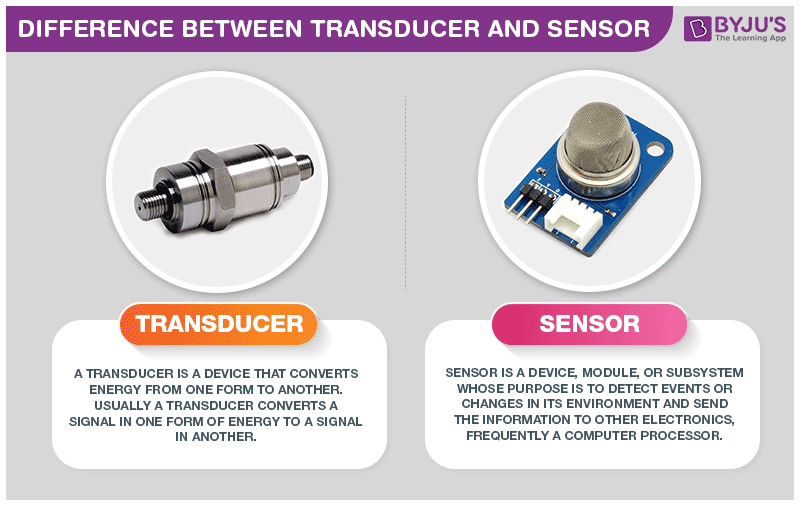In the world of technology and measurement, the difference between transducer and sensor is significant. A transducer is a device that converts one form of energy into another, such as converting mechanical energy into electrical signals. On the other hand, a sensor is a device that detects and responds to a specific input, such as light, temperature, pressure, or motion and converts it into a measurable output. While these terms are often used interchangeably, it is essential to recognize their distinct characteristics and functionalities. This article will explore the differences between transducers and sensors. Furthermore, we will address some frequently asked questions to deepen your understanding of these vital electronic components.
| Table of Contents: |
What is the Difference between Transducer and Sensor?
 Below is a table explaining the main differences between transducers and sensors:
Below is a table explaining the main differences between transducers and sensors:
| Difference between Transducer and Sensor | |
| Transducer | Sensor |
| Converts one form of energy into another form. | Senses physical quantities and converts them into signals read by an instrument. |
| Converts electricity to electromagnetic waves | Senses physical quantity and converts it into an analog quantity |
| Examples of Transducers: Antenna, microphones, loudspeakers | Examples of a Sensor: LED, touch sensors in automobiles, pressure switches. |
| Converts the measured quantity into a standard electrical signal like -10 to +10V DC | Measures voltage, capacitance, inductance, and ohmic resistance |
To grasp the differences more clearly, let’s consider some examples. An accelerometer, which measures acceleration, is a type of sensor. It detects the changes in acceleration and converts them into electrical signals for further analysis. In contrast, a microphone is a typical example of a transducer. It converts sound waves into electrical signals that can be amplified, recorded, or transmitted.
It is important to note that the key difference between a sensor and a transducer lies in their primary functions. A transducer primarily focuses on converting one form of energy into another, whereas a sensor concentrates on detecting and measuring a specific input. Additionally, transducers often require an external power source, while sensors can function using the energy from the input they detect.
|
You may also want to explore the following related topics! |
| LED stands for Light Emitting Diode which is a p-n junction device with high resolution, whereas LCD stands for Liquid Crystal Display and is an optical device with low resolution.
Read more: The difference between LCD and LED |
| Reflection is the phenomenon of light where the light rebounds after hitting the surface, whereas refraction is the phenomenon of light where the light ray bends as it passes through two mediums. |
What is a Transducer?
Transducers can be categorized into two main types based on their functionality: input transducers and output transducers. Input transducers enable the detection and measurement of a specific input, such as temperature changes, pressure variations, or light intensity. Input transducers convert physical quantities or environmental stimuli into electrical signals. These electrical signals are then used for further analysis.
On the other hand, output transducers, also known as actuators, convert electrical signals into physical action or output. They receive electrical signals as input and generate a corresponding non-electrical output, such as mechanical motion, heat, or light. Output transducers are widely used in various applications, including robotics, automation systems, and display technologies. It is important to note that transducers can also function bidirectionally, acting as input and output devices depending on the application.
Examples of a Transducer
Thermocouple: A thermocouple is a transducer commonly used for temperature measurement. Thermocouples are widely employed in industries, laboratories, and HVAC systems for temperature monitoring and control.
Microphones: Microphones are another familiar example of transducers. They convert sound waves travelling through the air into electrical signals. These electrical signals can then be amplified, recorded, or transmitted for various applications, including audio recording, public address systems, telecommunication, and more.
Transducers like thermocouples and microphones demonstrate how different forms of energy, such as temperature and sound, can be converted into electrical signals. These examples of transducers highlight the transducer’s practical applications and versatility.
What is a Sensor?
A sensor is an essential device utilized to measure and detect physical changes or environmental conditions in the surroundings. It captures parameters such as temperature, light intensity, pressure and motion and converts them into readable electrical signals for further analysis, monitoring, or control.
Examples of a Sensors
Barometer: A barometer is a sensor used to measure atmospheric pressure. It detects the changes in air pressure caused by weather conditions and converts them into electrical signals. These signals can then be interpreted to determine whether the pressure rises or falls, providing valuable information for weather forecasting, aviation, and meteorological applications.
Accelerometer: An accelerometer is a sensor that measures acceleration or changes in velocity. It is commonly used in smartphones, gaming controllers, and vehicle stability systems. Accelerometers detect linear acceleration and tilt in multiple directions and convert them into electrical signals. This enables the detection of motion, orientation, and vibration, allowing for applications like screen rotation, gesture recognition, and impact detection.
Frequently Asked Questions – FAQs
What is a Transducer?
What are the examples of a Transducer?
What is a Sensor?
What are the examples of a Sensor?
What is the main difference between a transducer and a sensor?
Stay tuned to BYJU’S and Fall in Love with Learning!

Comments